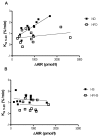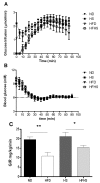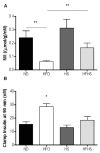Differential development of glucose intolerance and pancreatic islet adaptation in multiple diet induced obesity models
- PMID: 23201760
- PMCID: PMC3497000
- DOI: 10.3390/nu4101367
Differential development of glucose intolerance and pancreatic islet adaptation in multiple diet induced obesity models
Abstract
Background: The C57BL/6 mouse fed a high fat diet is a common and valuable model in experimental studies of obesity and type 2 diabetes (T2D). Different high fat diets are used and in order to determine which diet produces a model most accurately resembling human T2D, they need to be compared head-to-head.
Methods: Four different diets, the 60% high fat diet (HFD) and the 58% high fat-high sucrose Surwit diet (HFHS) and their respective controls, were compared in C57BL/6J mice using glucose tolerance tests (IVGTT) and the euglycemic clamp.
Results: Mice fed a HFD gained more weight than HFHS fed mice despite having similar energy intake. Both high fat diet models were glucose intolerant after eight weeks. Mice fed the HFD had elevated basal insulin, which was not seen in the HFHS group. The acute insulin response (AIR) was unchanged in the HFD group, but slightly increased in the HFHS diet group. The HFHS diet group had a threefold greater total insulin secretion during the IVGTT compared to its control, while no differences were seen in the HFD group. Insulin sensitivity was decreased fourfold in the HFD group, but not in the HFHS diet group.
Conclusion: The HFD and HFHS diet models show differential effects on the development of insulin resistance and beta cell adaptation. These discrepancies are important to acknowledge in order to select the appropriate diet for specific studies.
Figures





Similar articles
-
Effects of acute exposure to a high-fat, high-sucrose diet on gestational glucose tolerance and subsequent maternal health in mice.Biol Reprod. 2017 Feb 1;96(2):435-445. doi: 10.1095/biolreprod.116.144543. Biol Reprod. 2017. PMID: 28203773
-
Taurine supplementation prevents morpho-physiological alterations in high-fat diet mice pancreatic β-cells.Amino Acids. 2012 Oct;43(4):1791-801. doi: 10.1007/s00726-012-1263-5. Epub 2012 Mar 15. Amino Acids. 2012. PMID: 22418865
-
Cigarette smoke exposure impairs β-cell function through activation of oxidative stress and ceramide accumulation.Mol Metab. 2020 Jul;37:100975. doi: 10.1016/j.molmet.2020.100975. Epub 2020 Mar 13. Mol Metab. 2020. PMID: 32283079 Free PMC article.
-
The Oikawa-Nagao Mouse: A Polygenic Animal Model for Unraveling the Pathophysiology of Type 2 Diabetes and Obesity.J Nippon Med Sch. 2025;92(1):2-9. doi: 10.1272/jnms.JNMS.2025_92-104. J Nippon Med Sch. 2025. PMID: 40058831 Review.
-
The role of dietary components in leptin resistance.Adv Nutr. 2012 Sep 1;3(5):736-8. doi: 10.3945/an.112.002659. Adv Nutr. 2012. PMID: 22983859 Free PMC article. Review. No abstract available.
Cited by
-
High fat diet attenuates hyperglycemia, body composition changes, and bone loss in male streptozotocin-induced type 1 diabetic mice.J Cell Physiol. 2018 Feb;233(2):1585-1600. doi: 10.1002/jcp.26062. Epub 2017 Aug 4. J Cell Physiol. 2018. PMID: 28631813 Free PMC article.
-
Methods and models for metabolic assessment in mice.J Diabetes Res. 2013;2013:986906. doi: 10.1155/2013/986906. Epub 2013 May 21. J Diabetes Res. 2013. PMID: 23762879 Free PMC article.
-
High-Fat Diets Alter the Modulatory Effects of Xenobiotics on Cytochrome P450 Activities.Chem Res Toxicol. 2018 May 21;31(5):308-318. doi: 10.1021/acs.chemrestox.8b00008. Epub 2018 May 4. Chem Res Toxicol. 2018. PMID: 29688711 Free PMC article.
-
Impact of glucose dosing regimens on modeling of glucose tolerance and β-cell function by intravenous glucose tolerance test in diet-induced obese mice.Physiol Rep. 2014 May 19;2(5):e12011. doi: 10.14814/phy2.12011. Print 2014 May 1. Physiol Rep. 2014. PMID: 24843074 Free PMC article.
-
You are what you eat, or are you? The challenges of translating high-fat-fed rodents to human obesity and diabetes.Nutr Diabetes. 2014 Sep 8;4(9):e135. doi: 10.1038/nutd.2014.30. Nutr Diabetes. 2014. PMID: 25198237 Free PMC article. Review.
References
-
- Boden G., Shulman G.I. Free fatty acids in obesity and type 2 diabetes: Defining their role in the development of insulin resistance and beta-cell dysfunction. Eur. J. Clin. Invest. 2002;32:14–23. - PubMed
-
- Kahn S.E. The relative contributions of insulin resistance and beta-cell dysfunction to the pathophysiology of type 2 diabetes. Diabetologia. 2003;46:3–19. - PubMed
-
- Ritzel R.A., Butler A.E., Rizza R.A., Veldhuis J.D., Butler P.C. Relationship between beta-cell mass and fasting blood glucose concentration in humans. Diabetes Care. 2006;29:717–718. - PubMed
Publication types
MeSH terms
Substances
LinkOut - more resources
Full Text Sources
Medical

